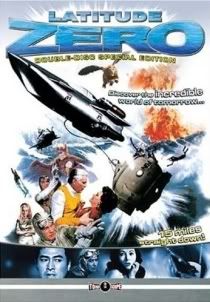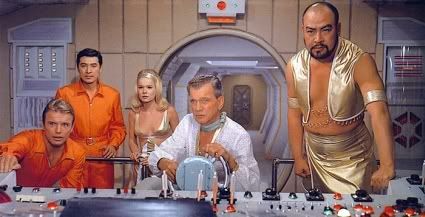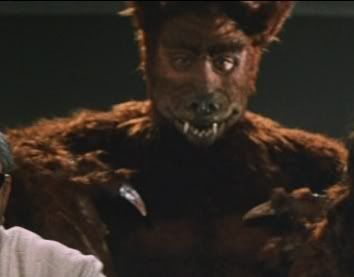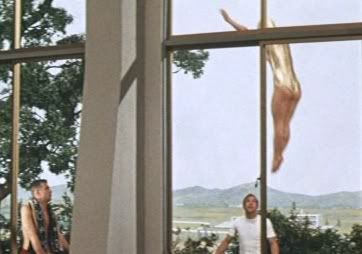 NEW YORK, December 25 — Finally, a Special Edition Double DVD of Latitude Zero (aka "Ido zero daisakusen") has been released in the United States (Release Date: December 11, 2007). It was released by Tokyo Shock, a subsidiary of Media Blasters.
NEW YORK, December 25 — Finally, a Special Edition Double DVD of Latitude Zero (aka "Ido zero daisakusen") has been released in the United States (Release Date: December 11, 2007). It was released by Tokyo Shock, a subsidiary of Media Blasters.Latitude Zero is an underwater tokusatsu adventure by Ishirô Honda, the director of Gojira. It's a sci-fi film centered on Latitude Zero, an Atlantis-like underwater utopia. It's a classic Toho Studios production.
First, I want to address the matter of the packaging. The packaging is pretty stripped down for a "special edition". I was hoping for more extras and liner notes, instead the box was filled with Media Blasters advertisements. This advertising stuffing included a fold-out catalogue and a DVD of trailers. It was disappointing.

When "cult" films such as Latitude Zero are transferred to DVD, they are frequently victims of poor packaging and stripped down DVD authoring. Media companies just produce these DVD releases with very little creativity or care. The Latitude Zero release follows this trend of bland packaging and presentation.
Tokyo Shock could have paid a writer and a graphic designer to create an interesting booklet and box cover. It would cost very little money to produce.
Let’s get back to the film...

Crew of the Alpha submarine.
Before I reviewed this film, I read a lot of internet reviews on Latitude Zero. Many mainstream movie reviewers gave this film a bad review. However, I don't think it's really that bad. Latitude Zero has its problems, but it's a decent film. It is just misunderstood.
I understand that Latitude Zero is not for everyone. For many mainstream movie goers, many standard Japanese tokusatsu films (such as Gojira) are perceived as too weird and sometimes incomprehensible. Guys wearing large rubber monster costumes are still a little alien to western audiences.
However, Latitude Zero is just a step beyond the standard tokusatsu fare. This film was Honda's attempt to create a mixture of a western style sci-fi adventure with Japanese visual effects. He was trying to target both an American and Japanese audience simultaneously.

Capt. McKenzie (Cotten) catches a bullet with his bare hands.
The cast was a unique mix of western and Japanese actors. The most notable western actors were Cesar Romero (The Joker from TV's Batman) and Joseph Cotten (Citizen Kane). They are joined by Akira Takarada (Gojira: Fainaru uôzu, Gojira, and Kingdom Hearts Video Games) and Masumi Okada (Brother Michael from TV's Shogun). Takarada is veteran Godzilla actor and a staple of Toho Pictures. His tokusatsu career spans the entire history of Godzilla films from the original 1956 Godzilla film to Godzilla: Final Wars.
The movie was also filmed in English, and many of the Japanese actors had to learn English. Some of the Japanese actors had the English script broken down into phonetic katakana in order to learn it. If you listen carefully to the Japanese actors, you will hear extra syllables and trailing sounds at the end of words. This is mostly due to learning English from reading the katakana phonetics.

Mutant humanoid bat henchmen.
The story of Latitude Zone begins in the Pacific Ocean. A research team is lowering a deep sea diving bell into the ocean. Two Japanese scientists (Takarada and Okada) and an American journalist (Richard Jaeckel) are diving into the deepest part of the ocean in order to study temperature shifts. An underwater volcano suddenly erupts, and their deep sea diving bell crashes to the bottom. They are quickly rescued by Captain Craig McKenzie (Cotten) and his uncanny submarine crew. After the rescue, the Alpha, McKenzie's submarine, is quickly pursued and attacked by the Black Shark, Doctor Malic's (Romero) submarine. An action filled underwater pursuit begins.
If you are fan of early sci-fi films, Latitude Zero will be a bizarre cinematic treat. Most of Latitude Zero's story deals with the concepts of a utopian society and the miracle of scientific progress during the early 20th century. The film portrays science as both a destructive force and a nurturing one. The ambivalent feelings toward scientific progress are a familiar theme to many sci-fi movie fans. In many respects, Latitude Zero is very similar to The Thing from Another World (1951), Voyage to the Prehistoric Planet (1965), and Forbidden Planet (1956).

Giant griffin versus a submarine.
This film also has a good helping of Kaiju fun. It is an Ishirô Honda film after all. The crew of the Alpha battles humanoid bat creatures, giant rats, and a large furry Griffin monster. Many kaiju fans will also recognize the orchestral score. Music for the film was provided by Akira Ifukube, composer for most of the Godzilla films.
Latitude Zero does suffer from some pacing issues. The exposition scenes are painfully slow in the movie. Honda tried to stuff a political message into the long dialogue scenes, but it was completely awkward. He was trying to argue that the Cold War has tainted the noble pursuit of scientific research and human governments could not be trusted. It was a little too didactic, and it was a drag on the story.
In the end, Latitude Zero is not for everyone. However, if you enjoy a bizarre cinematic sci-fi experience, I highly encourage you to pick-up Ishirô Honda's Latitude Zero.

Ohh... Did I mention that they have girls on trampolines!


1 comment:
You write very well.
Post a Comment